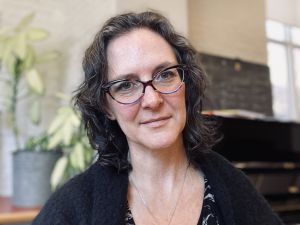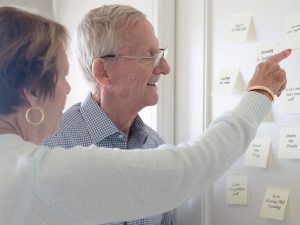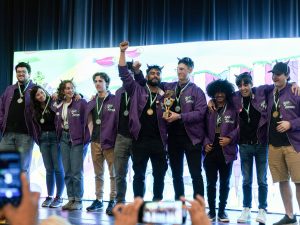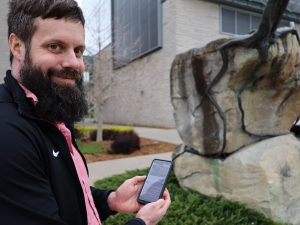 Keri Ewart, a Teacher Education instructor, developed an online version of the KAIROS Blanket Exercise. Her husband and two children acted out the folding of the blankets in her living room.
Keri Ewart, a Teacher Education instructor, developed an online version of the KAIROS Blanket Exercise. Her husband and two children acted out the folding of the blankets in her living room. When classes at Brock University moved online due to the COVID-19 pandemic, Keri Ewart found herself planning an unusual virtual alternative to a critical unit for teacher candidates in her Social Studies class.
Ewart, a Teacher Education instructor, developed an online version of the KAIROS Blanket Exercise to help teacher candidates better understand the shared history of Indigenous and non-Indigenous peoples in Canada from pre-contact to the present day.
The interactive history lesson was developed by KAIROS Canada in collaboration with Indigenous Elders, Knowledge Keepers and educators. There is no online version of the exercise.
“This activity is so powerful and has such an impact that I wanted to do its virtual replication justice,” said Ewart, who is a trained Blanket Exercise facilitator.
Under normal circumstances, participants would use a script and blankets spread out on the floor, representing the lands of Indigenous peoples, to learn about their experiences. In their roles, participants would represent either Indigenous or non-Indigenous people to explore multiple perspectives and learn the silenced stories of Indigenous peoples.
For many, seeing the blankets or fellow participants removed from the floor to symbolize the loss of lands or lives is a powerful representation of trauma experienced by Indigenous people.
As well as finding primary sources such as videos, photos, original scrolls, treaties and scripts, Ewart recorded her husband, son and daughter acting out the folding and removal of blankets on her living room floor. In addition to the video, Ewart assigned each student a role to play from the Blanket Exercise script.
Fifth-year Concurrent Teacher Education student Sarah Warner said having prior knowledge about the activity made her skeptical of participating online due to it being such an interactive activity, but was impressed by Ewart’s ability to make it successful even in an unconventional format.
“Keri did a fantastic job at making the activity as engaging as possible by having all of us read a part of the script, use of visuals that are relevant and videos of the actual activity,” said Warner.
Ewart received positive feedback from teacher candidates and observed that some were visibly emotional during the online exercise.
“We were able to move beyond the screen to a place where everybody had felt that impact,” said Ewart. “I think it’s important for educators to continue to do everything they can to evoke emotion in their students and explore key issues through an e-learning platform by taking the time to include relevant information and engage in critical literacies all through multimodal means.”
Teacher candidates in Ewart’s class are learning instructional strategies as well as the content matter through critical and creative means.
“Observing the ways faculty and instructors teach is an important part of their education,” said Ewart.
She hopes the strategies she models for her students will prepare them for their placements and roles as future teachers, and also hopes that the transition to an online learning environment encourages them to take risks in their teaching in order to meet the needs of students, such as using technology in meaningful ways to promote creative interactive activities.
“You are not going to be the expert all the time,” said Ewart, noting that a “growth mindset” is important. “Students are curious, competent, capable and need to be actively involved in their learning journey.”
Teacher candidates in Ewart’s class have expressed new-found confidence in their abilities to work with technology in their future classrooms.
“Through this activity and the entire course, Keri has made me embrace technology more, even if I’m not super confident when using it in a meaningful way,” said Warner. “It has better prepared me to take risks when teaching and to not be afraid to learn alongside the students when using different forms of technology, websites or apps.”
As well as having a growth mindset, using real-world experiences and fostering collaboration with peers are key to engaging in online learning, said Ewart, who has taught around the globe on effective and meaningful integration of technology in different systems.
“During this uncertain time, my thinking and learning have been challenged beyond what I could have ever imagined possible,” she said.
“Even though courses are all virtual, the tasks you assign need to be engaging, critical and purposeful.”









